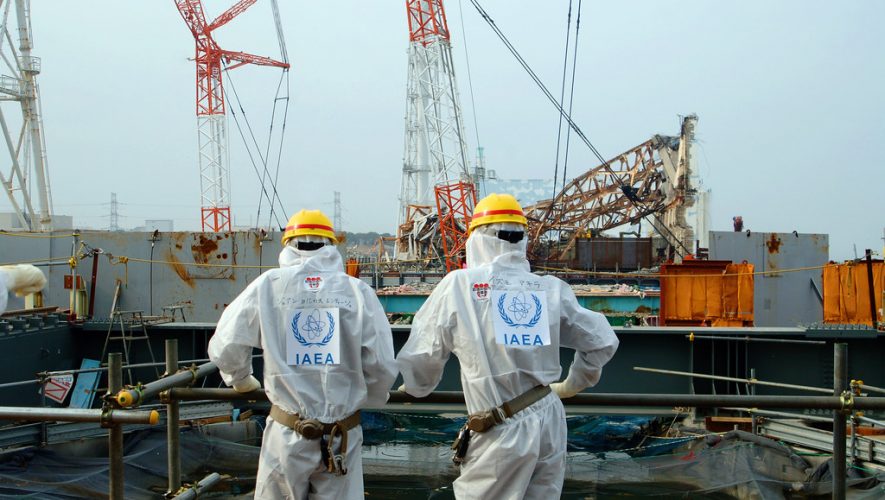In October 2020, then-Prime Minister Suga Yoshihide declared that Japan would reach net-zero greenhouse gas emission by 2050, an extremely high hurdle for the country to achieve in just thirty years. Japan is among the world’s largest carbon emitters, with forty percent of its emissions coming from energy production; in 2019, fossil fuels composed 88 percent of the country’s total primary energy supply. Overhaul of the country’s energy production systems is thus an integral part of the Government of Japan’s (GOJ) plan to achieve carbon neutrality.
A critical part of the GOJ’s overhaul plan is restarting and expanding nuclear power, which halted after the 2011 Fukushima Daiichi nuclear disaster. Given the immense amount of carbon-free energy nuclear produces, the Kishida administration has prioritized enhancing Japan’s nuclear power capacity. However, the GOJ faces an uphill battle in restarting and expanding nuclear: unsafe systems and regulations destroyed most of the Japanese public’s trust in nuclear energy, and for good reason.
The Fukushima disaster was a wake-up call to the public on the exploitative and unsafe nature of Japan’s nuclear power industry. The private energy utilities sustaining the system employ dangerous and corrupt practices. The national regulatory mechanisms designed to protect the public fail to implement basic safety policies and hold companies accountable. These conditions directly resulted in the 2011 disaster and exposed the system’s dark underbelly.
On the other hand, Japan—both as a member of the global community and an island nation vulnerable to climate change—must decarbonize its economy. Given the current lack of robust renewable energy infrastructure, experts estimate that Japan must restart thirty of its nuclear reactors by 2030 to reach its obligations under the Paris Climate Accords. At the moment, the country operates just nine.
Thus, as the country looks toward its decarbonized future, two profoundly complicated realities emerge. Japan’s nuclear energy system is exploitative of low-income communities, technically unsafe, and politically unpopular. However, in the context of global climate change, decarbonized economies are clearly the future, and Japan’s current energy infrastructure is incapable of going green in the short term without nuclear power.
Therefore, the future of nuclear energy in Japan is uncertain. Its sustained existence jeopardizes public safety and contradicts democratic practice. Its removal threatens the country’s efforts to decarbonize. The GOJ is at a crossroads, trapped between Japan’s dark nuclear past and the short-term need for it in the country’s fight for survival. Which path it chooses will bring long-term implications for the country’s energy independence, democratic practices, and path towards carbon neutrality.
Systemically Flawed
The state’s predatory policies sustain Japan’s nuclear infrastructure and drive economic inequality. Across the country, one trend persists in any community that hosts a nuclear power facility: they are rural and socioeconomically insecure. The country’s poorest communities shoulder the burden and danger of producing electricity for Japan’s urban centers. This deeply unequal system is by no means a coincidence. In fact, this was very much by design.
To expand nuclear power capacity, Tokyo has employed a policy toolkit to override local resistance in nuclear host communities since the 1970s. By targeting poor municipalities, the central government created economic dependence on nuclear power plants.
The state did so through financial and economic incentives for towns to host new projects, mainly hefty national subsidies with a uniquely predatory structure. The GOJ paid enormous sums of money to local governments during the construction of new reactors. The immense size of the construction projects at nuclear facilities likewise contributed to local economies by bringing unprecedented employment levels. Most towns spent this money on desperately needed public works projects, otherwise impossible investments.
However, the GOJ structures payments such that upon a reactor’s completion, funding reduces to a fraction of the original amount. Most of these small-town governments had no prior experience in handling such tremendous amounts of money and opted for much-needed capital investments rather than ones targeted at long-term economic growth. As the national payments shrank, so did local governments’s ability to pay for newly steep budgets and costs. Local governments had no other choice but to construct more nuclear reactors at these power facilities to maintain cash inflow from Tokyo. For example, Kashima City in Ibaraki Prefecture received up to $90 million in the early 1990s for constructing an additional reactor at local facilities—this was nearly half of the city’s municipal budget.
This quick cash from Tokyo quickly restructured economies away from their industrial bases; nuclear host economies never stood a chance to develop robustly. Exploitation and economic inequality are the foundation of Japan’s nuclear production capabilities; the system itself drives unequal development.
The state implemented other coercive policies, including soft social control techniques in host communities. Tokyo held pro-nuclear public relations campaigns, dispatched high-level bureaucrats to implore opposed citizens, and created “atomic energy centers” for politicians to meet with local residents. The state also established fish farms and published pro-nuclear articles in fishery magazines to appease local fishery cooperatives, which hold significant political power in rural Japan. In doing so, Tokyo worked to forcefully coerce public opinion at the local level to accept nuclear plants.
The Japanese state thus employed a two-pronged approach to developing the country’s nuclear infrastructure. It used predatory financial incentives to force economic dependence on rural municipalities while shaping local opinion to pacify its citizenry. There are thus major, systemic issues of economic exploitation and inequality built in the country’s nuclear energy system.
Institutional Failures
As the 2011 Fukushima disaster revealed, much of Japan’s nuclear power system is built on and sustained by unsafe practices and poor regulation. Two sets of institutions are to blame for the dangerous state of affairs: private power utilities and national regulatory mechanisms.
Japan’s national power system consists of ten privately-owned utility companies that hold monopolies over regions of the country. By far the largest of the ten is Tokyo Electric Power Company Holdings Inc. (TEPCO), the former operator of Fukushima Daiichi. TEPCO, along with other utility companies, have consistently endangered the public through reckless and corrupt practices.
After the 2011 disaster, an independent panel of the National Diet concluded that TEPCO was well aware of the structural vulnerabilities at the plant stemming from the outdated earthquake safety codes from the time of Daiichi’s construction. However, the company failed to implement proper earthquake safety checks and maintenance protocols despite regulations that required it to do so. In 2008, TEPCO ran simulations that proved Daiichi was at immense risk of a tsunami disaster but did not report this to regulators for nearly three years. The company willingly left the plant unprotected. This overwhelming negligence resulted in the 2011disaster.
The government likewise had a significant role in allowing TEPCO, the country’s largest energy utility and producer of nuclear energy, to act so recklessly. Through a process that the Diet panel labeled as “collusion,” regulators failed to implement the most basic oversight in nuclear safety. The since-disbanded Nuclear and Industrial Safety Agency (NISA) was responsible for both the promotion and regulation of nuclear power, a clear conflict of interest. Accordingly, NISA failed to hold TEPCO accountable for updating earthquake safety features at Daiichi. The agency accepted substandard safety reports from TEPCO and allowed the company to voluntarily follow safety regulations. The GOJ allowed TEPCO to jeopardize the nation’s safety by failing to regulate it properly.
The disaster at Fukushima Daiichi was profoundly man-made and preventable. To state otherwise would ignore TEPCO’s reckless behavior and nuclear regulatory mechanisms’s complicity in creating the conditions that caused the disaster. It was a direct result of Japan’s unsound nuclear energy systems.
Despite the clear failures of national institutions that caused the Fukushima disaster, these same institutions fail to implement adequate change. One would assume that mankind’s second-worst nuclear disaster would motivate these parties to implement safe and strict procedures.
TEPCO’s immediate crisis response was reckless and seriously endangered the Japanese public. Thankfully, workers at Daiichi ignored much of the company’s incorrect emergency recommendations, which ultimately averted catastrophe. After the immediate crisis, TEPCO remained reckless and untransparent in its decommissioning efforts at Daiichi. The company lied about the radioactivity level in the stored wastewater used to cool the melted uranium fuel, which reached up to 20,000 times the legal limit. For two months, it claimed that the tsunami caused mere “core damage” even though it had data suggesting up to 55 percent of the uranium fuel melted down, a clear worst-case scenario for any nuclear plant.
The company’s recovery efforts featured unsafe practices and lacking transparency. TEPCO made dangerous mistakes like spilling three hundred tons of highly radioactive wastewater, leaving earthquake detection instruments broken for months, building drinking water stations in hazardous areas, or dangerously miswiring electrical equipment at Daiichi.
Though certainly the clearest examples, TEPCO’s constant failures are by no means limited to Daiichi. At Kashiwazaki-Kariwa, the largest nuclear power plant on earth, cases of unauthorized access to highly sensitive areas continue to occur. In multiple instances, unauthorized personnel even gained access to the plant’s central control room by using other employees’s identification. Such relaxed security practices jeopardize national safety and greatly contribute to the lack of public trust in TEPCO.
In 2019, the public’s little faith in Japan’s nuclear industry further diminished when Kansai Electric Power Co. Inc.’s (KEPCO) officers accepted payoffs from a municipal official of a nuclear host town. In total, the official paid some ¥4 million (around $27,691 in 2019 dollars) in cash and expensive gifts to KEPCO executives after the company started nuclear construction projects at the Takahama Nuclear Power Station. In addition to government collusion, internal corruption persists in Japan’s nuclear energy producers.
Japan’s nuclear energy system continues to be sustained by dangerous, reckless, and corrupt practices. Even a disaster on the scale of that at Fukushima Daiichi has done little to motivate nuclear institutions to systemically reform.
Politically Unpopular
Nuclear power remains deeply unpopular among the Japanese public. The public perception of nuclear power’s safety deeply shifted after the Fukushima disaster and subsequent exposure to the failures of Japan’s government and energy utilities.
Nationally, the public is clearly against restarting and expanding nuclear power production. As of 2020, a mere 2.2 percent of the Japanese public support the expansion of nuclear power. Meanwhile, some 48 percent support the phasing out of nuclear power in the coming years, by far the most popular preference. Further, on the tenth anniversary of the triple disaster in 2021, five former prime ministers—among them, the famously conservative and previously pro-nuclear Prime Minister Koizumi Junichiro—jointly called for the country to phase out nuclear power. It is politically unpopular even among some nationally recognized conservatives.
Nuclear power also remains deeply unwanted at local levels, particularly in host communities. Since Japan’s nuclear plants shut down in 2011, locals have consistently lobbied against their restarting out of safety fears. In 2012, locals from Fukui Prefecture sued KEPCO to prevent it from restarting two reactors at its Oi plant. In 2020, residents surrounding the Shikoku Electric Power Company’s Itaka plant filed multiple lawsuits with the Hiroshima High Court to halt restarting the plant’s reactors. Last year, an Ibaraki Prefecture court ordered the suspension of the Tokai Nuclear Plant following lawsuits from local citizens. Across the country, a clear trend is emerging: both the local host communities and the broader public no longer trust nuclear power.
An Uncertain Future
The country’s nuclear production system is unpopular given its exploitative and technically unsound state. Democratic norms dictate that the GOJ would divest from Japan’s nuclear infrastructure. However, as the country moves towards a decarbonized model, it has few short-term options for supplementing its fossil fuel-based energy production. Japan is at a crossroads and faces two complex choices for achieving carbon neutrality; either path will bring long-term impacts to the country’s democracy and energy systems.
The first choice is for Tokyo to implement policies that are receptive to public opinion: phase out nuclear power. In Japan’s context, this is by far the most democratic and safe option for transitioning its production model. However, doing so would deeply jeopardize the government’s decarbonization efforts.
Ironically, Japan’s current energy infrastructure creates a reality where the safest and most democratic approach to producing energy is one that acts against long-term national interests. Therefore, if the GOJ divests from nuclear, it should also rapidly invest in other renewables like wind, solar, geothermal, and hydrogen. It has already made strides in this field; the Kishida Cabinet made “clean energy” and a commitment to decarbonization a core element of its growth strategy. Other governmental bodies have likewise committed to this effort, like in April of this year, when the Ministry of Economy, Trade, and Industry changed the incentive structure for renewable suppliers to reduce costs on consumers and promote renewables. Additionally, at the end of 2021, the Bank of Japan introduced a green bond scheme to foster investments in clean technology.
While such measures are steps in the right direction, they serve a renewables-focused model that includes nuclear power and fall short of the systemic change necessary to make nuclear obsolete. Further and widespread investment from Tokyo to replace nuclear power would require rapid infrastructure development and regulatory structures to enhance market competitiveness for renewable companies. Even then, Japan would face a serious uphill battle in reaching its carbon-neutral goal.
The second choice is the course that the GOJ is already embarking on: to move against the public’s wishes and push nuclear onto the country’s decarbonized production model. In 2021, the GOJ’s Sixth Energy Plan called for 20-22 percent of Japan’s energy to come from nuclear power. While this could greatly aid the country’s rapid transition from fossil fuels, doing so would throw the weight of the Japanese state against public opinion, setting a dangerous precedent for undemocratic practices in national decisions. The GOJ has not implemented systemic change in Japan’s nuclear production system and the public has little reason to trust Tokyo and energy utilities with their safety blindly once again.
If the GOJ continues with its unpopular nuclear energy policy, it must also implement systemic change. First, regulatory mechanisms must thoroughly regulate Japan’s energy utilities. The recklessness and corruption shown by these companies actively endanger the Japanese public, as was proven at Daiichi in 2011. Transparent practices, increased safety regulations, and strict government oversight are necessary to prevent further disasters and rebuild public trust. If the Japanese state undemocratically embraces nuclear, it must also embrace change.
Recent global developments further complicate Japan’s future relationship with nuclear power. The Russian-Ukrainian war has sent the cost of domestic energy—most of which is imported—soaring. Additionally, in March of this year, around two million households under TEPCO’s grid lost power after a magnitude 7.4 earthquake disrupted the regional power supply. Under such conditions, public opinion slightly moved towards restarting nuclear power. Ruling Liberal Democratic Party members seized the opportunity and doubled down with pushing for nuclear restarts. However, they have done so without releasing comprehensive, effective plans for addressing the systemic issues with nuclear power in Japan. Therefore, Tokyo seems poised to continue down its dangerous path of pushing for nuclear power without creating safe conditions for its sustained usage.
Whichever course the GOJ adopts for its nuclear policy, its decision will deeply impact the country’s democracy and course towards decarbonization. Japan is at a crossroads and will need to confront its dark nuclear past to reckon with its carbon-neutral future.



